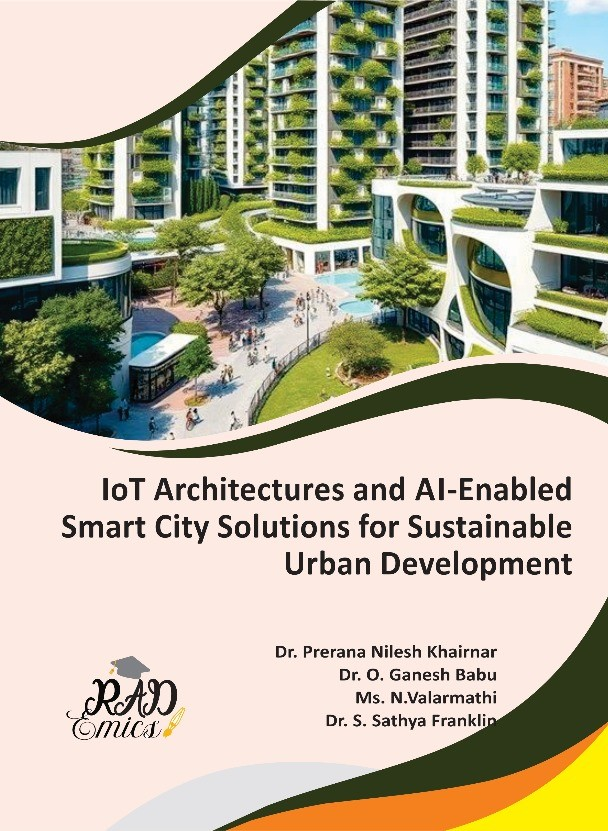
Peer Reviewed Chapter
Chapter Name : AI Driven Disaster Management and Early Warning Systems for Emergency Response and Urban Resilience Planning
Author Name : Muthuselvi Rajendran, Gayathri Vairam, Nivetha Ganesan
Copyright: ©2025 | Pages: 38
DOI: 10.71443/9789349552241-15
Received: 22/12/2024 Accepted: 15/03/2025 Published: 24/04/2025
Abstract
The integration of Artificial Intelligence (AI) into disaster management systems offers transformative potential in enhancing emergency response, urban resilience, and crisis mitigation strategies. This book chapter explores the pivotal role of AI-driven early warning systems, focusing on their application in urban disaster management. It examines how AI can optimize decision-making processes, facilitate real-time data analysis, and improve predictive capabilities for natural and man-made disasters. The chapter also delves into the challenges of integrating AI with existing disaster management frameworks, ensuring interoperability with traditional tools, and fostering collaboration between governmental and private sector entities. Additionally, it highlights the importance of maintaining transparency and accountability in AI-based systems to ensure public trust and the equitable allocation of resources. By presenting a comprehensive overview of AI's role in modern disaster response, this chapter provides key insights into how AI technologies can significantly enhance preparedness, reduce response times, and improve outcomes in urban resilience planning. The future of AI in disaster management lies in its ability to complement human decision-making, optimize communication networks, and deliver actionable insights for more effective crisis coordination.
Introduction
The rapid advancement of Artificial Intelligence (AI) technologies has brought about transformative changes in a variety of fields, with disaster management standing out as one of the most impactful sectors [1]. Traditional methods of disaster response often struggle to keep up with the complexities and scale of modern crises [2]. In this context, AI-driven solutions offer the promise of more efficient, timely, and targeted interventions. By leveraging AI’s capabilities to analyze large datasets, predict disaster scenarios, and optimize response strategies, urban centers can enhance their resilience to a wide array of threats, ranging from natural disasters such as hurricanes and earthquakes to human-made crises like industrial accidents or terrorist attacks [3]. This book chapter explores the integration of AI in disaster management systems, focusing on early warning mechanisms, real-time decision-making, and coordinated response efforts, particularly in urban environments [4].
In the realm of disaster management, AI plays a crucial role in the development of early warning systems that can detect and predict impending disasters with greater accuracy and speed than traditional methods [5]. Machine learning algorithms, for example, can process vast amounts of historical data, sensor inputs, and environmental monitoring results to generate highly reliable forecasts [6]. These predictions not only help in alerting authorities and the public but also provide vital information to inform evacuation plans, resource allocation, and other critical decisions [7]. AI’s capacity to continuously improve its predictions based on new data further enhances the responsiveness of early warning systems, making them more adaptive to evolving threats [8]. This dynamic capability is particularly important in urban areas, where the rapid flow of information and coordination between various agencies is essential for mitigating the impacts of disasters [9].
As urban areas continue to expand and face increasing vulnerability to both natural and human-induced hazards, the role of AI in enhancing urban resilience has become paramount [10]. Urban environments are particularly susceptible to the cascading effects of disasters, which can have far-reaching consequences on infrastructure, public health, and economic stability [11]. AI-driven systems can analyze urban-specific data, such as population density, infrastructure layouts, and traffic patterns, to provide insights into the most effective ways to manage and respond to crises [12]. AI can help in simulating different disaster scenarios, allowing cities to better plan for potential outcomes and reduce the risk of catastrophic failures [13]. These predictive models can also guide infrastructure development, ensuring that urban areas are built to withstand future crises and minimize damage [14].